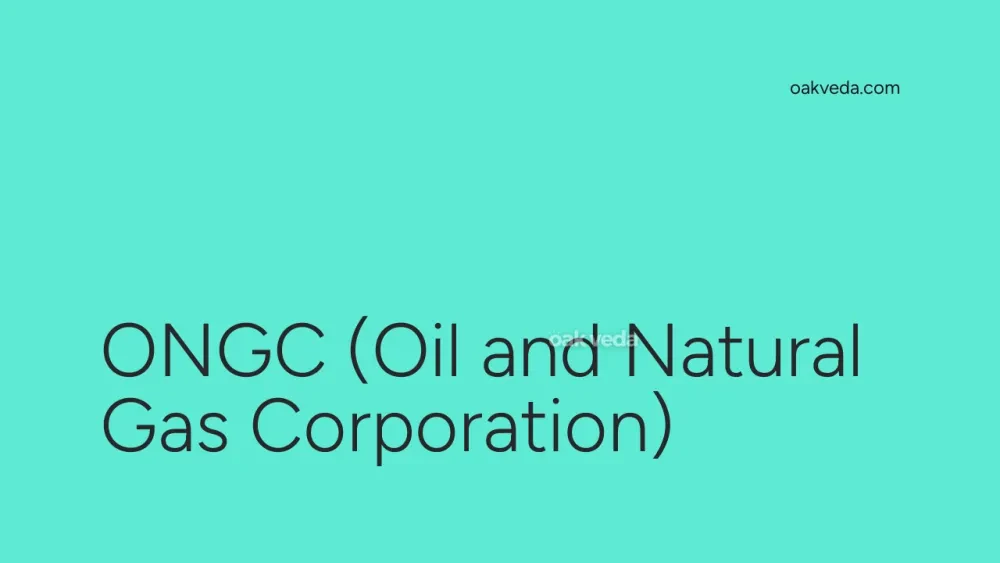
What is the Full Form of ONGC?
The full form of ONGC is Oil and Natural Gas Corporation. This state-owned enterprise plays a crucial role in India's energy sector, focusing on the exploration and production of oil and natural gas resources.
What is Oil and Natural Gas Corporation?
Oil and Natural Gas Corporation (ONGC) is India's largest crude oil and natural gas company. Established on August 14, 1956, it operates under the administrative control of the Ministry of Petroleum and Natural Gas, Government of India. ONGC is a multinational corporation with its headquarters in New Delhi, India.
Origin and Development of Oil and Natural Gas Corporation
The inception of ONGC can be traced back to India's post-independence era:
- In 1955, the Indian government established the Department for Oil and Natural Gas under the Ministry of Natural Resources and Scientific Research.
- The Industrial Policy Resolution of 1956 included the oil and gas sector among the Schedule 'A' industries, elevating its importance.
- ONGC was initially formed as the Oil and Natural Gas Commission, which was later restructured as a limited enterprise under the Companies Act, 1956.
- In 1994, ONGC was converted into a public limited company.
- The company expanded its operations globally in 2002-03 by forming ONGC Videsh Ltd. (OVL) as its subsidiary.
How does Oil and Natural Gas Corporation work?
ONGC operates through a complex network of exploration, production, and distribution activities:
- Exploration: ONGC conducts geological surveys and seismic studies to identify potential oil and gas reserves both onshore and offshore.
- Drilling: Once potential reserves are identified, ONGC drills exploratory wells to confirm the presence of hydrocarbons.
- Production: If commercially viable reserves are found, ONGC sets up production facilities to extract oil and natural gas.
- Refining: The company processes crude oil and natural gas to produce various petroleum products.
- Distribution: ONGC works with other companies to distribute its products across India and internationally.
Functions of Oil and Natural Gas Corporation
ONGC's primary functions include:
- Exploration and production of oil and natural gas
- Development of new oil and gas fields
- Research and development in petroleum technology
- Contribution to India's energy security
- Promotion of sustainable and environmentally friendly practices in the oil and gas sector
Applications of Oil and Natural Gas Corporation
ONGC's products and services find applications in various sectors:
- Energy: Providing fuel for power generation and transportation
- Petrochemicals: Supplying raw materials for the production of plastics, fertilizers, and other chemicals
- Domestic use: Offering LPG for cooking and heating purposes
- Industrial applications: Providing lubricants and other petroleum-based products for machinery and equipment
Features of Oil and Natural Gas Corporation
Key features of ONGC include:
- Integrated operations: ONGC is involved in all aspects of the oil and gas value chain, from exploration to distribution.
- Technological innovation: The company invests heavily in research and development to improve exploration and production techniques.
- Global presence: Through ONGC Videsh Ltd., the company has operations in multiple countries.
- Diversified product portfolio: ONGC produces a wide range of petroleum products, including crude oil, natural gas, LPG, and various petrochemicals.
Benefits of Oil and Natural Gas Corporation
ONGC's operations provide several benefits to India:
- Energy security: By producing domestic oil and gas, ONGC reduces India's dependence on imports.
- Economic growth: The company contributes significantly to India's GDP and provides employment opportunities.
- Technological advancement: ONGC's R&D efforts drive innovation in the energy sector.
- Strategic partnerships: The company collaborates with international firms, fostering knowledge exchange and technological transfer.
Limitations or Challenges of Oil and Natural Gas Corporation
Despite its success, ONGC faces several challenges:
- Declining domestic production: Many of India's oil fields are maturing, leading to reduced output.
- Environmental concerns: The oil and gas industry faces increasing pressure to reduce its carbon footprint.
- Global price fluctuations: Volatile oil prices can impact ONGC's profitability and investment decisions.
- Competition: The company faces competition from private and international oil companies in India's liberalized energy market.
Future Developments in Oil and Natural Gas Corporation Technology
ONGC is focusing on several areas for future growth:
- Enhanced oil recovery: Implementing advanced techniques to extract more oil from existing fields
- Deep-water exploration: Investing in technologies to explore and produce oil from deep-water reserves
- Renewable energy: Diversifying into solar and wind energy to reduce carbon emissions
- Digitalization: Adopting artificial intelligence and big data analytics to improve operational efficiency
FAQs on ONGC Full Form
-
What does ONGC produce? ONGC produces crude oil, natural gas, LPG, superior kerosene oil, motor spirit, and aromatic-rich naphtha.
-
When was ONGC established? ONGC was established on August 14, 1956.
-
Is ONGC a government company? Yes, ONGC is a public sector undertaking under the administrative control of the Ministry of Petroleum and Natural Gas, Government of India.
-
What is the role of ONGC Videsh Ltd.? ONGC Videsh Ltd. is a subsidiary of ONGC that focuses on international oil and gas operations.
-
How does ONGC contribute to India's energy security? ONGC contributes to India's energy security by exploring, producing, and supplying oil and natural gas from domestic and international sources.
You may be interested in:

